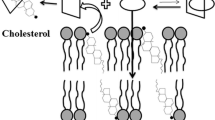Abstract
Purpose. The extent of adsorption.of different drug molecules to κ-carrageenan was investigated in order to evaluate the effect of drug hydrophobicity on the adsorption isotherm.
Methods. Dialysis experiments were used to determine the amount of drug adsorbed to the polyelectrolyte. The amount of drug on both sides of the membrane was determined spectrophotometrically after attaining equlibrium. CMC for the drugs were determined by the dye solubilisation method.
Results. It is shown that the small differences in structure between the drug molecules used in this study still leads to considerable difference in adsorption properties, especially the onset of adsorption. It was also found that the slope of the adsorption isotherms among the drug molecules followed the same pattern as the CMC values for drugs. The extent of adsorption of drugs to the helix form of κ-carrageenan was much higher than to the coil form.
Conclusions. These results suggest that the adsorption of charged drug molecules to an oppositely charged polymer is effected not only by the coulombic interactions, but also by the hydrophobicity of the drug. Furthermore, the adsorption of drug molecules to κ-carrageenan in the helix form is higher than for the coil form because of the shorter distance between the charges and the thereby enhanced hydrophobic interaction between bound drug molecules.
Similar content being viewed by others
REFERENCES
A. T. Florence and D. Attwood. Physicochemical principles of pharmacy. (Second ed.) Macmillan, London, 1992.
E. D. Goddard. Polymer-surfactant interaction Part II. Polymer and surfactant of opposite charge. Colloids and Surfaces. 19:301–329 (1986).
N. Caram-Lelham and L.-O. Sundelöf. Changes in the polyelectrolyte-amphiphile interaction due to helix-coil transition induced by specific counterions or variations in temperature. Accepted for publication in Biopolymers.
N. Caram-Lelham and L.-O. Sundelöf. Some aspects on characterization and properties of charged polysaccharides. An investigation of the system carrageenan/amitriptyline/water with relation to amphiphile adsorption and charge density. Int. J. Pharm. 115:103–111 (1995).
N. Caram-Lelham, R. L. Cleland, and L.-O. Sundelöf. Temperature and salt optimization of κ-carrageenan fractionation by DEAE-cellulose. Int. J. Biol. Macromol. 16:71–75 (1994).
Y. Li, P. L. Dubin, H. A. Havel, S. L. Edwards, and H. Dautzenberg. Electrophoretic light scattering, dynamic light scattering, and turbidimetry studies of the effect of polymer concentration on complex formation between polyelectrolyte and oppositely charged mixed micelles. Macromolecules. 28:3098–3102 (1995).
K. Hayakawa, J. P. Santerre, and J. C. T. Kwak. Study of surfactant-polyelectrolyte interactions. Binding of dodecyl-and tetrade-cyltrimethylammonium bromide by some carboxylic polyelectrolytes. Macromolecules. 16:1642–1645 (1983).
A. Malovikova, K. Hayakawa, and J. C. T. Kwak. Surfactant-polyelectrolyte interactions. 4. Surfactant chain length dependence of the binding of alkylpyridinium cations to dextran sulfates. J. Phys. Chem. 88:1930–1933 (1983).
K. Hayakawa and J. C. T. Kwak. Surfactant-polyelectrolyte interactions. 1. Binding of dodecyltrimethylammonium ions by sodium dextran sulfate and sodium poly(styrenesulfonate) in aqueous solution in the presence of sodium chloride. J. Phys. Chem. 86:3866–3870 (1982).
A. C. Moffat. Clarke's isolation and identification of drugs. (Second ed.) The Pharmaceutical Press, London, 1986.
D. Attwood and J. Gibson. Aggregation of antidepressant drugs in aqueous solution. J. Pharm. Pharmac. 30:176–180 (1978).
D. Attwood and R. Natarajan. Miceliar properties of chlorpromazine hydrochloride in concentrated electrolyte solutions. J. Pharm. Pharmacol. 35:317–319 (1983).
C. Rochas and M. Rinaudo. Activity coefficients of counterions and conformation in kappa-carrageenan systems. Biopolymers 19:1675–1687 (1980).
T. H. M. Snoeren and T. A. J. Payens. On the sol-gel transition in solutions of kappa-carrageenan. Biochim. Biophys. Acta 437:264–272 (1976).
B. J. Kvam and H. Grasdalen. Probe for the conformational transition of carrageenans. Effect of Mn2+induced 1H NMR relaxation of tetramethylammonium ions in aqueous tetramethylammonium carrageenate solutions. Macromolecules 22:3919–3928 (1989).
Author information
Authors and Affiliations
Rights and permissions
About this article
Cite this article
Caram-Lelham, N., Sundelöf, LO. The Effect of Hydrophobic Character of Drugs and Helix-coil Transition of κ-Carrageenan on the Polyelectrolyte-drug Interaction. Pharm Res 13, 920–925 (1996). https://doi.org/10.1023/A:1016017515366
Issue Date:
DOI: https://doi.org/10.1023/A:1016017515366




